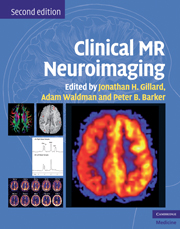Book contents
- Frontmatter
- Contents
- Contributors
- Case studies
- Preface to the second edition
- Preface to the first edition
- Abbreviations
- Introduction
- Section 1 Physiological MR techniques
- Section 2 Cerebrovascular disease
- Section 3 Adult neoplasia
- Chapter 21 Adult neoplasia
- Chapter 22 Magnetic resonance spectroscopy in adult neoplasia
- Chapter 23 Diffusion MR imaging in adult neoplasia
- Chapter 24 Perfusion MR imaging in adult neoplasia
- Chapter 25 Permeability imaging in adult neoplasia
- Chapter 26 Functional MR imaging in presurgical planning
- Section 4 Infection, inflammation and demyelination
- Section 5 Seizure disorders
- Section 6 Psychiatric and neurodegenerative diseases
- Section 7 Trauma
- Section 8 Pediatrics
- Section 9 The spine
- Index
- References
Chapter 22 - Magnetic resonance spectroscopy in adult neoplasia
from Section 3 - Adult neoplasia
Published online by Cambridge University Press: 05 March 2013
- Frontmatter
- Contents
- Contributors
- Case studies
- Preface to the second edition
- Preface to the first edition
- Abbreviations
- Introduction
- Section 1 Physiological MR techniques
- Section 2 Cerebrovascular disease
- Section 3 Adult neoplasia
- Chapter 21 Adult neoplasia
- Chapter 22 Magnetic resonance spectroscopy in adult neoplasia
- Chapter 23 Diffusion MR imaging in adult neoplasia
- Chapter 24 Perfusion MR imaging in adult neoplasia
- Chapter 25 Permeability imaging in adult neoplasia
- Chapter 26 Functional MR imaging in presurgical planning
- Section 4 Infection, inflammation and demyelination
- Section 5 Seizure disorders
- Section 6 Psychiatric and neurodegenerative diseases
- Section 7 Trauma
- Section 8 Pediatrics
- Section 9 The spine
- Index
- References
Summary
Introduction
The socioeconomic impact of adult primary brain neoplasms is disproportionate to their incidence; they often affect young adults, cause significant morbidity, and are usually ultimately fatal. Moreover, advances in treatment of primary malignancies outside the CNS has led to more aggressive clinical management of brain metastases.
Reliable characterization of intracranial masses is, therefore, essential for rational clinical management: in initial diagnosis and prognosis, stratification and planning of therapy for individual patients, and evaluating outcome with established and novel treatment regimens.
The relatively high risk of performing invasive procedures in the brain places particular emphasis on neuroimaging in the evaluation of brain masses. Conventional structural MRI and computed tomography (CT) are widely used in clinical practice but provide limited biological specificity and diagnostic and prognostic information. Non-invasive physiological imaging techniques that augment the information available from structural imaging and inform clinical management are clearly desirable.
- Type
- Chapter
- Information
- Clinical MR NeuroimagingPhysiological and Functional Techniques, pp. 295 - 320Publisher: Cambridge University PressPrint publication year: 2009

